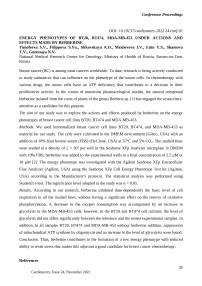Energy phenotypes of BT20, BT474, MDA-MB-453 under actions and effects made by berberine
Автор: Timofeeva S.V., Filippova S.Yu., Sitkovskaya A.O., Mezhevova I.V., Enin Y.S., Shamova T.V., Gnennaya N.V.
Журнал: Cardiometry @cardiometry
Статья в выпуске: 24, 2022 года.
Бесплатный доступ
Breast cancer (BC) is among most cancers worldwide. To date, research is being actively conducted to study substances that can influence on the phenotype of the tumor cells. In chemotherapy with various drugs, the tumor cells have an ATP deficiency that contributes to a decrease in their proliferative activity. In the course of numerous pharmacological studies, the natural compound berberine isolated from the roots of plants of the genus Berberis sp. [1] has engaged the researchers' attention as a candidate for this purpose. The aim of our study was to explore the actions and effects produced by berberine on the energy phenotypes of breast cancer cell lines BT20, BT474 and MDA-MB-453.
Короткий адрес: https://sciup.org/148326312
IDR: 148326312 | DOI: 10.18137/cardiometry.2022.24.conf.20
Текст статьи Energy phenotypes of BT20, BT474, MDA-MB-453 under actions and effects made by berberine
National Medical Research Centre for Oncology, Ministry of Health of Russia, Rostov-on-Don, Russia
Breast cancer (BC) is among most cancers worldwide. To date, research is being actively conducted to study substances that can influence on the phenotype of the tumor cells. In chemotherapy with various drugs, the tumor cells have an ATP deficiency that contributes to a decrease in their proliferative activity. In the course of numerous pharmacological studies, the natural compound berberine isolated from the roots of plants of the genus Berberis sp. [1] has engaged the researchers’ attention as a candidate for this purpose.
The aim of our study was to explore the actions and effects produced by berberine on the energy phenotypes of breast cancer cell lines BT20, BT474 and MDA-MB-453.
Methods . We used immortalized breast cancer cell lines BT20, BT474, and MDA-MB-453 as material for our study. The cells were cultivated in the DMEM environment (Gibco, USA) with an addition of 10% fetal bovine serum (FBS) (HyClone, USA) at 37°C and 5% CO 2 . The studied lines were seeded at a density of 2 × 104 per well in the Seahorse XFp Analyzer microplate in DMEM with 10% FBS; berberine was added to the experimental wells to a final concentration of 2.5 μM or 10 μM [2]. The energy phenotype was investigated with the Agilent Seahorse XFp Extracellular Flux Analyzer (Agilent, USA) using the Seahorse XFp Cell Energy Phenotype Test kit (Agilent, USA) according to the Manufacturer's protocol. The statistical analysis was performed using Student's t-test. The significance level adopted in the study was α = 0.05.
Results . According to our research, berberine inhibited dose-dependently the basic level of cell respiration in all the studied lines, without having a significant effect on the reserve of oxidative phosphorylation. A decrease in the oxygen consumption was accompanied by an increase in glycolysis in the MDA-MB-453 cells, however, in the BT20 and BT474 cell cultures, the level of glycolysis did not differ significantly between the reference and the tested experimental samples. In addition, in all samples BT20, BT474 and MDA-MB-453 without berberine addition, suppression of mitochondrial ATP synthase by oligomycin and an increase in the level of glycolysis were found. Conclusion . Thus, berberine contributes to the formation of a low energy phenotype with reduced ability to resist stress that makes this adjuvant a good candidate for breast cancer chemotherapy.
Список литературы Energy phenotypes of BT20, BT474, MDA-MB-453 under actions and effects made by berberine
- Mezhevova I.V., et al. Antimigratory effect of berberine in T98G, U87MG and primary glioma cell culture. Journal of Clinical Oncology. 2021. No. suppl 15. P. e15045.
- Filippova S.Yu., et al. Effect of berberine on the energy phenotype of breast cancer cell lines. International Journal of Applied and Basic Research. 2021;10:42-26.


